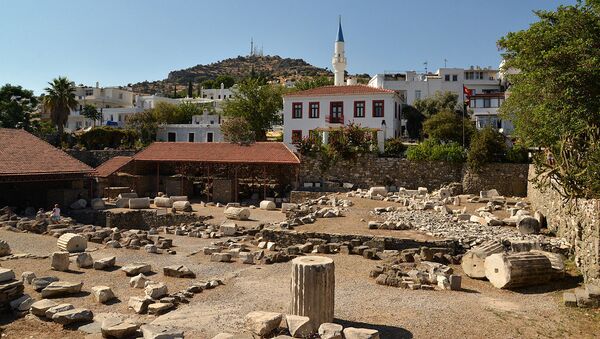The discovery was made during a drought at a local water reservoir where water levels have receded from 82 meters to only 8 meters through the lack of rainfall, according to Sputnik Türkiye.
Sular çekilince ortaya çıktı!: Çömlekçi köyü adı verilen eski yerleşim yerinde, sular… https://t.co/l4SPGrmgYy
— Haber Müdürü (@tvitmatik) 20 ноября 2016 г.
Çömlekçi was established over 300 years ago by Yörük nomads migrating from Anatolia.
#Bodrum'daki Mumcular Barajı'nda suların çekilmesinin ardından 300 yıllık yerleşim yeri Çömlekçi Köyü gün yüzüne çıktı. pic.twitter.com/kmzdfip6Kp
— dokuz8 (@dokuz8haber) 22 ноября 2016 г.
The settlement used to be a tile and pottery craft village. Archaeologists have already uncovered ruins of a tile workshop, an inn, seven windmills and several aqueducts.
Bodrum'da sular çekildi, 3 asırlık köy ortaya çıktı https://t.co/pgr0l8SBSr pic.twitter.com/a9xPFa7cv8
— Sonhaber (@sonhaber) 20 ноября 2016 г.
The village was flooded in 1955 when the government decided to convert the territory where it was situated into a water reservoir.
Barajda sular çekildi, 3 asırlık köy ortaya çıktı https://t.co/WzbJS6rJcd pic.twitter.com/NBZgHjfWKC
— CNN Türk (@cnnturk) 21 ноября 2016 г.
Ayşe Temiz, head of the archaeological and historian body within the Bodrum city council, said that all artifacts uncovered at the site will be thoroughly studied and properly catalogued, according to the Doğan News Agency.
"Sooner or later nature allows people to feel the breath of history and to touch its forgotten pages. In my opinion, this is a priceless discovery that sheds light on the region’s past," Temiz said.
Baraj suları çekilince 3 asırlık köy ortaya çıktıhttps://t.co/kRIPIJZCLT pic.twitter.com/evVv1JCLrQ
— Furkan Haber (@furkanhabernet) 20 ноября 2016 г.
She also added that a team of archaeologists is expected to arrive soon to help secure the artifacts and to deliver them to the archaeological museum of Bodrum.

